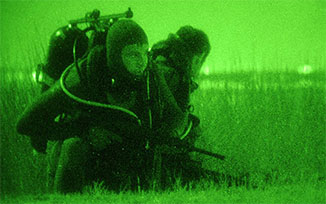U.S. Army Special Reaction Team (SRT)
U.S. Army Special Reaction Teams (SRTs) are specialised military police units that are trained to respond to crisis situations at Army installations.
Special Reaction Team - Role
Like civilian police SWAT units, SRTs may be called in to deal with incidents beyond the capabilities of regular police units. SRTs are trained to deal with:
- active shooters
(shooting sprees such as the Fort Hood shootings) - barricaded suspects
- hostage rescue
- counter terrorism
- VIP protection
- high-risk arrests
- sniper incidents
Army SRTs are similar in role to USMC Special Reaction Teams and USAF Emergency Services Teams (ESTs).
Special Reaction Team - Video
Special Reaction Team - Organization
Special Reaction Team members are drawn from the Military Police stationed at a given U.S. Army installation.
A typical U.S. Army SRT is split into two main elements:
- Entry Team
- 1 Team leader
- 1 Pointman
- 2 Defensemen
- 1 Rear Security
- Marksman Observer Team
- Shooter
- Spotter
Entry Teams are armed with M4 carbines, M16 rifles, MP5 smgs, m9 beretta 9mm pistols and 12-guage shotguns. The pointman may carry a ballistic shield. Battering rams may be carrried in order to force entry. Marksmen may be armed with the M24 SWS or M1110 7.62mmx51mm sniper rifles.
Special Reaction Team - Selection & Training
SRT candidates, all experienced MPs, undergo an extensive selection and training process before becoming part of the team. Selection includes fitness tests, a record review and psychological screening. A two-phase training program at the US Army Military Police School prepares SRT candidates for life in the teams.
- Special Reaction Team Course - Phase 1 : the 2 week phase one course teaches building entry and clearing, breaching, occupancy control, instictive firearm shooting, rappelling, hostage situation psychology, negotiation, intelligence reporting and incident pre-planning. Phase 1 trainers may include former Ranger NCOs, some of which have undertaken special forces close quarters combat (CQC) courses. The course is split into 20 hours of classroom instruction and 67 hours of practical exercises.
- Special Reaction Team Course - Phase 2: a 1 week course for SRT Marksman Observers, teaching advanced marksman techniques including shooting and range and distance gathering techniques.
Special Reaction Team Photos









